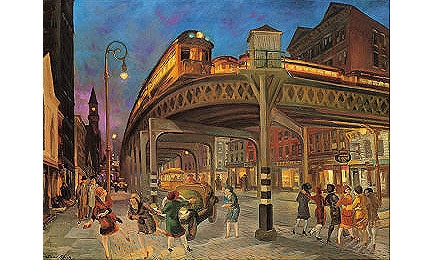|
Modern Art Film Clips  A review of the Stuart Davis (1892 – 1964) retrospective that opened at New York's Museum of Modern Art in the fall of 1945. The artist referred to his influences: "In my own case I have enjoyed the dynamic American scene for many years, and all my pictures (including the ones I painted in Paris) are referential to it. They all have their originating impulse in the impact of [the]contemporary American environment."
"Against the backdrop of a metropolis, a painter finds exultation in the vigorous beauty of the common girl."
"Recent paintings from Paris have been brought to New York by Pierre Matisse (1900 – 1989) and are now on view at his 57th Street Gallery [at the Fuller Building]. Represented are the Pierre Bonnard, Jean Dubuffet, Andre Marchand, Henri Matisse, Pablo Picasso, Georges Rouault." Max Beckmann (1884 – 1950), having fled to Holland from his native Germany in order to escape Hitler, arrived in New York shortly after the end of the war and wasted no time in securing an aggressive dealer eager to arrange liasons between him and the the post-war dollar. "The first exhibition of Max Beckman's work since 1941 is currently being held at the Bucholz Gallery in New York. Director Kurt Valentin has assembled for this event important examples of Beckman's brush dating from 1939 to the present...Among the many drawings particularly remembered are a satirical 'Radio Singer' and a tongue-in-cheek 'Anglers', along with 'Head Waiters'." The U.S. had only been actively engaged in World War II for five months when the American artist Rockwell Kent (1882 – 1971) felt the impulse to write about the unique roll an artist must play when a democracy goes to war:
"The art of a democracy must be, like democracy itself, of and by and for the people. It must and will reflect the public mood and public interest...Awareness of America, of its infinitely varied beauties and of its sometimes sordid ugliness; awareness of the life of America, of its fulfillments and its failures; awareness, if you like, of God, the landscape architect supreme - and political failure: of the promise of America and of its problems, art has been, or has aimed to be, a revelation. It is for the right to solve these problems our way that we are now at war." |
MORE ARTICLES >>> PAGE: * 1 * 2 * 3 * 4 * 5 * 6 * 7 * 8 * 9 * 10 * 11 * > NEXT |
|